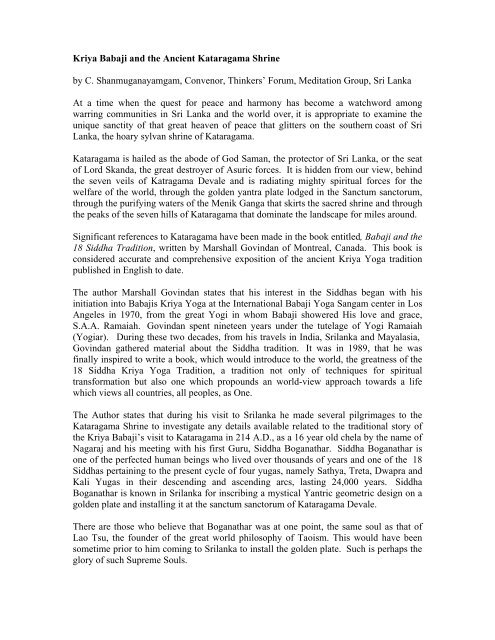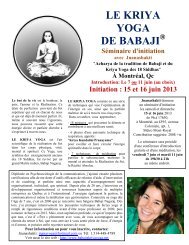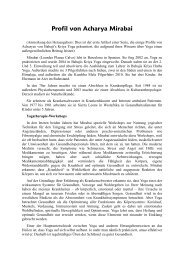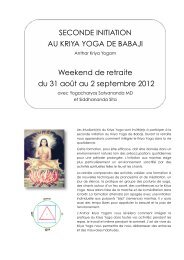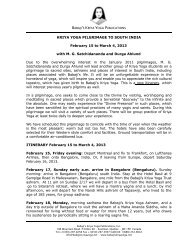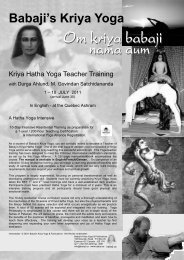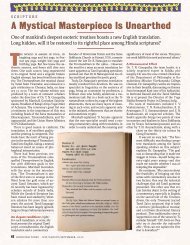Kriya Babaji and the Ancient Kataragama Shrine - Babaji's Kriya Yoga
Kriya Babaji and the Ancient Kataragama Shrine - Babaji's Kriya Yoga
Kriya Babaji and the Ancient Kataragama Shrine - Babaji's Kriya Yoga
You also want an ePaper? Increase the reach of your titles
YUMPU automatically turns print PDFs into web optimized ePapers that Google loves.
<strong>Kriya</strong> <strong>Babaji</strong> <strong>and</strong> <strong>the</strong> <strong>Ancient</strong> <strong>Kataragama</strong> <strong>Shrine</strong><br />
by C. Shanmuganayamgam, Convenor, Thinkers’ Forum, Meditation Group, Sri Lanka<br />
At a time when <strong>the</strong> quest for peace <strong>and</strong> harmony has become a watchword among<br />
warring communities in Sri Lanka <strong>and</strong> <strong>the</strong> world over, it is appropriate to examine <strong>the</strong><br />
unique sanctity of that great heaven of peace that glitters on <strong>the</strong> sou<strong>the</strong>rn coast of Sri<br />
Lanka, <strong>the</strong> hoary sylvan shrine of <strong>Kataragama</strong>.<br />
<strong>Kataragama</strong> is hailed as <strong>the</strong> abode of God Saman, <strong>the</strong> protector of Sri Lanka, or <strong>the</strong> seat<br />
of Lord Sk<strong>and</strong>a, <strong>the</strong> great destroyer of Asuric forces. It is hidden from our view, behind<br />
<strong>the</strong> seven veils of Katragama Devale <strong>and</strong> is radiating mighty spiritual forces for <strong>the</strong><br />
welfare of <strong>the</strong> world, through <strong>the</strong> golden yantra plate lodged in <strong>the</strong> Sanctum sanctorum,<br />
through <strong>the</strong> purifying waters of <strong>the</strong> Menik Ganga that skirts <strong>the</strong> sacred shrine <strong>and</strong> through<br />
<strong>the</strong> peaks of <strong>the</strong> seven hills of <strong>Kataragama</strong> that dominate <strong>the</strong> l<strong>and</strong>scape for miles around.<br />
Significant references to <strong>Kataragama</strong> have been made in <strong>the</strong> book entitled, <strong>Babaji</strong> <strong>and</strong> <strong>the</strong><br />
18 Siddha Tradition, written by Marshall Govindan of Montreal, Canada. This book is<br />
considered accurate <strong>and</strong> comprehensive exposition of <strong>the</strong> ancient <strong>Kriya</strong> <strong>Yoga</strong> tradition<br />
published in English to date.<br />
The author Marshall Govindan states that his interest in <strong>the</strong> Siddhas began with his<br />
initiation into <strong>Babaji</strong>s <strong>Kriya</strong> <strong>Yoga</strong> at <strong>the</strong> International <strong>Babaji</strong> <strong>Yoga</strong> Sangam center in Los<br />
Angeles in 1970, from <strong>the</strong> great Yogi in whom <strong>Babaji</strong> showered His love <strong>and</strong> grace,<br />
S.A.A. Ramaiah. Govindan spent nineteen years under <strong>the</strong> tutelage of Yogi Ramaiah<br />
(Yogiar). During <strong>the</strong>se two decades, from his travels in India, Srilanka <strong>and</strong> Mayalasia,<br />
Govindan ga<strong>the</strong>red material about <strong>the</strong> Siddha tradition. It was in 1989, that he was<br />
finally inspired to write a book, which would introduce to <strong>the</strong> world, <strong>the</strong> greatness of <strong>the</strong><br />
18 Siddha <strong>Kriya</strong> <strong>Yoga</strong> Tradition, a tradition not only of techniques for spiritual<br />
transformation but also one which propounds an world-view approach towards a life<br />
which views all countries, all peoples, as One.<br />
The Author states that during his visit to Srilanka he made several pilgrimages to <strong>the</strong><br />
<strong>Kataragama</strong> <strong>Shrine</strong> to investigate any details available related to <strong>the</strong> traditional story of<br />
<strong>the</strong> <strong>Kriya</strong> <strong>Babaji</strong>’s visit to <strong>Kataragama</strong> in 214 A.D., as a 16 year old chela by <strong>the</strong> name of<br />
Nagaraj <strong>and</strong> his meeting with his first Guru, Siddha Boganathar. Siddha Boganathar is<br />
one of <strong>the</strong> perfected human beings who lived over thous<strong>and</strong>s of years <strong>and</strong> one of <strong>the</strong> 18<br />
Siddhas pertaining to <strong>the</strong> present cycle of four yugas, namely Sathya, Treta, Dwapra <strong>and</strong><br />
Kali Yugas in <strong>the</strong>ir descending <strong>and</strong> ascending arcs, lasting 24,000 years. Siddha<br />
Boganathar is known in Srilanka for inscribing a mystical Yantric geometric design on a<br />
golden plate <strong>and</strong> installing it at <strong>the</strong> sanctum sanctorum of <strong>Kataragama</strong> Devale.<br />
There are those who believe that Boganathar was at one point, <strong>the</strong> same soul as that of<br />
Lao Tsu, <strong>the</strong> founder of <strong>the</strong> great world philosophy of Taoism. This would have been<br />
sometime prior to him coming to Srilanka to install <strong>the</strong> golden plate. Such is perhaps <strong>the</strong><br />
glory of such Supreme Souls.
Govindan says that much of he writes concerning <strong>Babaji</strong>’s birth in 203 A.D., on<br />
Karthikai Deepam day during <strong>the</strong> ascendancy of <strong>the</strong> constellation (nakshetra) Rohini,<br />
<strong>and</strong> about his visit to <strong>Kataragama</strong> in 214 A.D. was revealed in <strong>the</strong> books written in 1952,<br />
by <strong>Babaji</strong>’s disciple V.T. Neelakantan. These books were written when <strong>Babaji</strong><br />
materialized in physical form on several occasions in <strong>the</strong> puja room of Neelakantan at<br />
No. 9, Surammal Lane, Egmore, Madras <strong>and</strong> dictated verbatim, <strong>the</strong> contents of three<br />
mystical publications, which <strong>Babaji</strong> wanted published for <strong>the</strong> benefit of <strong>the</strong> world. (V.T.<br />
Neelakantan was a foreign correspondent <strong>and</strong> essayist <strong>and</strong> close friend of Jawaharlal<br />
Nehru <strong>and</strong> a student <strong>and</strong> admirer of Mrs. Annie Besant, <strong>the</strong> well-known Theosophical<br />
leader).<br />
Regarding <strong>the</strong> sojourn of <strong>Kriya</strong> <strong>Babaji</strong> at Kataragam in 214 A.D. as a 16 year old<br />
Nagaraj, <strong>the</strong> author states <strong>the</strong> following: “Sitting under a large spreading banyan tree<br />
with him (Siddha Boganathar) for six months Nagaraj performed intense Yogic sadhana<br />
particularly various Dhyana <strong>Kriya</strong>s into which he was initiated by Boganathar. The tapas<br />
was done for long periods without a break, initially for 24 hours <strong>and</strong> later for days, weeks<br />
<strong>and</strong> up to 48 days at a stretch. “The various mediation kriyas unchained his mind from<br />
<strong>the</strong> limiting processes of <strong>the</strong> thinking mind, allowing his consciousness to exp<strong>and</strong> <strong>and</strong><br />
realize its identity with an undifferentiated absolute Reality.”<br />
The author fur<strong>the</strong>r states that on his visits to <strong>Kataragama</strong> he traced <strong>the</strong> “sacred spot where<br />
<strong>Babaji</strong> practiced austerities under <strong>the</strong> large banyan tree. Unfortunately, some twenty<br />
years earlier, an insensitive man cut down this tree. A few days later, <strong>the</strong> man went mad<br />
<strong>and</strong> hanged himself. In 1989, a small shrine was built on <strong>the</strong> spot where <strong>the</strong> banyan had<br />
grown, which is near <strong>the</strong> front gate of <strong>the</strong> Temple of Theivanai Amman, Lord of<br />
Muruga’s consort, in <strong>the</strong> <strong>Kataragama</strong> temple complex. The Theivanai temple priest make<br />
daily offerings in <strong>the</strong> <strong>Babaji</strong> shrine.”<br />
Govindan describes <strong>the</strong> journey made by <strong>Babaji</strong> back to South India <strong>and</strong> his visit to<br />
Cuttalam to seek <strong>the</strong> final initiation in <strong>Kriya</strong> <strong>Yoga</strong> from <strong>the</strong> legendary Siddh Agastiya<br />
(who was Boganathar’s Guru). There <strong>Babaji</strong> did intense tapas for 48 days <strong>and</strong> was<br />
blessed by Agastiya <strong>and</strong> told to settle in Badrinath in <strong>the</strong> Himalayas <strong>and</strong> become <strong>the</strong><br />
greatest Siddha <strong>the</strong> world had ever known, with even <strong>the</strong> cells of his physical body<br />
divinized. (<strong>Babaji</strong> can still appear today, even though it is over 1800 years, since his<br />
physical birth in 203 A.D.)<br />
<strong>Babaji</strong> made it his mission to assist suffering humanity in <strong>the</strong>ir quest for God-realization.<br />
Usually he does so anonymously. Those helped by him generally do not know <strong>the</strong> source<br />
of <strong>the</strong>ir assistance. According to Lahiri Mahasaya, just by reciting <strong>Babaji</strong>’s name with<br />
reverence, a person receives a spiritual blessing.<br />
C. Shanmuganayamgam, Convenor, Thinkers’ Forum, Meditation Group, Sri<br />
Lanka tells of meeting with <strong>the</strong> great masters of <strong>Yoga</strong>, Paramahamsa Omkara Swami<br />
<strong>and</strong> Yogi Ramaiah in 1956. The three met again in 1957, when <strong>the</strong> young man was<br />
invited to accompany <strong>the</strong>m to perform a special Yagam in Colombo <strong>and</strong> also visited with<br />
<strong>the</strong>m in <strong>Kataragama</strong>, where <strong>the</strong>y bestowed blessings on <strong>the</strong> people by sonorous chanting<br />
of <strong>the</strong> AUM mantra.


